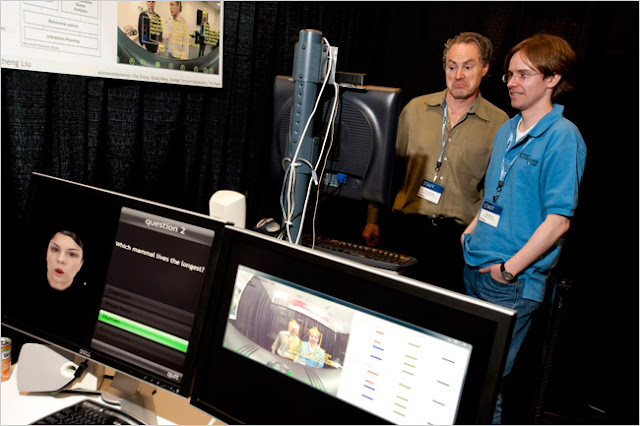Hrvoje Benko demonstrating a Microsoft projection system that lets people manipulate large video images with their hands
Corporate Governance
REDMOND, Wash.–March 9, 2009–Microsoft Corp announced that Maria Klawe, Ph.D., president of Harvey Mudd College, was appointed to the company’s board of directors, returning the board’s size to 10 members.
Whilst Klawe has made significant research contributions in several areas of mathematics and computer science, her current research interests include discrete mathematics, Serious Games and assistive technologies.
Pervasive Serious Games Apps
Lynn Marentette, in her superb Blog Interactive Multimedia Technology, has just published a most comprehensive post about Microsoft and the Future of Interaction.
There you may find what she has gathered about Microsoft's vision for the future across a variety of domains. This vision embeds some promising areas of research that may lead to solutions with a Serious Games approach.
The Situated Interaction project at Microsoft Research aims to enable a new generation of interactive systems that can reason about their surroundings and embed interaction deeply into the natural flow of everyday tasks, activities, and collaborations.
As an initial sample challenge in this space, researchers are currently developing a situated conversational agent that can act as a Microsoft front-desk receptionist (for example, make shuttle reservations, register visitors, and provide campus information).
The system integrates a large number of artificial intelligence technologies—such as speech recognition and language understanding, face detection and tracking, intention recognition, engagement, and behavioral modeling—in a conversational framework that allows it to engage in mixed-initiative, natural language interaction with one participant or multiple participants.
Find more in the below article.
Microsoft Mapping Course to a Jetsons-Style Future
Via: The New York Times
Meet Laura, the virtual personal assistant for those of us who cannot afford a human one.
Built by researchers at Microsoft, Laura appears as a talking head on a screen. You can speak to her and ask her to handle basic tasks like booking appointments for meetings or scheduling a flight.
Instead of being a relatively dumb terminal, Laura represents a nuanced attempt to recreate the finer aspects of a relationship that can develop between an executive and an assistant over the course of many years.
Microsoft wants to put a Laura on the desk of every person who has ever dreamed of having a personal aide. Laura and other devices like her stand as Microsoft’s potential path for diversifying beyond the personal computer, sales of which are stagnating.
Laura requires a top-of-the-line chip with eight processor cores to handle all of the artificial intelligence and graphics work needed to give the system a somewhat lifelike appearance and function. Such a chip would normally sit inside a server in a company’s data center.
Microsoft and its longtime partner, Intel, have accelerated their exploration of new computing fields. Late February, at its headquarters near Seattle, Microsoft showed off a host of software systems built to power futuristic games, medical devices and teaching tools.
Creators Dan Bohus, left, and Eric Horvitz as seen by Laura. The dot on Horvitz's nose indicates Laura's gaze. Laura analyzes that Bohus and Horvitz are Microsoft employees because of their casual attire, and Zicheng Liu, in the background, is not because he is wearing a blazer.





